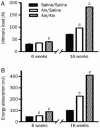Long-term effects of alendronate on fracture healing and bone remodeling of femoral shaft in ovariectomized rats
- PMID: 23459092
- PMCID: PMC4002493
- DOI: 10.1038/aps.2012.170
Long-term effects of alendronate on fracture healing and bone remodeling of femoral shaft in ovariectomized rats
Abstract
Aim: To investigate the long-term effects of alendronate (Aln), a widely used oral bisphosphonate, on fracture healing and bone remodeling in ovariectomized rats.
Methods: Adult female SD rats underwent ovariectomy, and then bilateral femoral osteotomy at 12 weeks post-ovariectomy. From d 2 post-ovariectomy, the animals were divided into 3 groups, and treated with Aln (3 mg·kg(-1)·d(-1), po) for 28 weeks (Aln/Aln), Aln for 12 weeks and saline for 16 weeks (Aln/Saline) or saline for 28 weeks (Saline/Saline). At 6 and 16 weeks post-fracture, the fracture calluses were examined with X-ray radiography, and biomechanical testing and histological analysis were performed. The calluses were labeled with tetracycline and calcein to evaluate the mineral apposition rate (MAR).
Results: The fracture line was less distinct in the 2 Aln-treated groups at 6 weeks post-fracture, and disappeared in all the 3 groups at 16 weeks post-fracture. The size of the callus and radiographic density of the femora in the Aln/Aln group were the highest among the 3 groups at 6 and 16 weeks post-fracture. Similar results were observed in the ultimate load at failure and energy absorption. However, the treatment with Aln delayed endochondral ossification of the callus, and significantly increased the total sagittal-sectional area, percentage callus area and callus thickness, and decreased the MAR at 6 and 16 weeks post-fracture.
Conclusion: In the ovariectomized rat model, Aln is beneficial for the mechanical properties of the callus, but delays callus remodeling by suppressing the remodeling of woven bone into lamellar bone.
Figures






Similar articles
-
Comparison of effects of alfacalcidol and alendronate on mechanical properties and bone collagen cross-links of callus in the fracture repair rat model.Bone. 2010 Apr;46(4):1170-9. doi: 10.1016/j.bone.2009.12.008. Epub 2009 Dec 22. Bone. 2010. PMID: 20026440
-
Raloxifene, estrogen, and alendronate affect the processes of fracture repair differently in ovariectomized rats.J Bone Miner Res. 2002 Dec;17(12):2237-46. doi: 10.1359/jbmr.2002.17.12.2237. J Bone Miner Res. 2002. PMID: 12469918
-
Effect of 1,25-dihydroxy vitamin D3 on fracture healing and bone remodeling in ovariectomized rat femora.Bone. 2009 May;44(5):893-8. doi: 10.1016/j.bone.2009.01.378. Epub 2009 Feb 5. Bone. 2009. PMID: 19442605
-
Zoledronic acid suppresses callus remodeling but enhances callus strength in an osteoporotic rat model of fracture healing.Bone. 2015 Dec;81:702-711. doi: 10.1016/j.bone.2015.09.018. Epub 2015 Oct 3. Bone. 2015. PMID: 26434668
-
Effect of dosing interval duration of intermittent ibandronate treatment on the healing process of femoral osteotomy in a rat fracture model.Calcif Tissue Int. 2012 Mar;90(3):193-201. doi: 10.1007/s00223-011-9563-4. Epub 2012 Jan 17. Calcif Tissue Int. 2012. PMID: 22249523 Free PMC article.
Cited by
-
Early bisphosphonate therapy post proximal femoral fracture fixation does not impact fracture healing: a systematic review and meta-analysis.ANZ J Surg. 2022 Nov;92(11):2840-2848. doi: 10.1111/ans.17792. Epub 2022 Jun 2. ANZ J Surg. 2022. PMID: 35655397 Free PMC article.
-
Sustained-release of sclerostin single-chain antibody fragments using poly(lactic-co-glycolic acid) microspheres for osteoporotic fracture repair.J Biomed Mater Res A. 2019 Aug;107(8):1832-1840. doi: 10.1002/jbm.a.36704. Epub 2019 May 10. J Biomed Mater Res A. 2019. PMID: 31012249 Free PMC article.
-
Effect of Tempeh and Daidzein on Calcium Status, Calcium Transporters, and Bone Metabolism Biomarkers in Ovariectomized Rats.Nutrients. 2024 Feb 26;16(5):651. doi: 10.3390/nu16050651. Nutrients. 2024. PMID: 38474779 Free PMC article.
-
Marantodes pumilum var. alata Enhances Fracture Healing Through Gene Regulation in a Postmenopausal Rat Model.Pharmaceuticals (Basel). 2025 May 16;18(5):736. doi: 10.3390/ph18050736. Pharmaceuticals (Basel). 2025. PMID: 40430554 Free PMC article.
-
The biology and treatment of acute long-bones diaphyseal fractures: Overview of the current options for bone healing enhancement.Bone Rep. 2020 Jan 28;12:100249. doi: 10.1016/j.bonr.2020.100249. eCollection 2020 Jun. Bone Rep. 2020. PMID: 32025538 Free PMC article. Review.
References
-
- Giannoudis P, Tzioupis C, Almalki T, Buckley R.Fracture healing in osteoporotic fractures: is it really different? A basic science perspective Injury 200738Suppl 1: S90–9. - PubMed
-
- Geusens P. Bisphosphonates for postmenopausal osteoporosis: determining duration of treatment. Curr Osteoporos Rep. 2009;7:12–7. - PubMed
-
- Müller D, Pulm J, Gandjour A. Cost-effectiveness of different strategies for selecting and treating individuals at increased risk of osteoporosis or osteopenia: a systematic review. Value Health. 2012;15:284–98. - PubMed
-
- Fu L, Tang T, Miao Y, Zhang S, Qu Z, Dai K. Stimulation of osteogenic differentiation and inhibition of adipogenic differentiation in bone marrow stromal cells by alendronate via ERK and JNK activation. Bone. 2008;43:40–7. - PubMed
-
- Schneider JP. Bisphosphonates and low-impact femoral fractures: current evidence on alendronate-fracture risk. Geriatrics. 2009;64:18–23. - PubMed
Publication types
MeSH terms
Substances
LinkOut - more resources
Full Text Sources
Other Literature Sources
Medical

